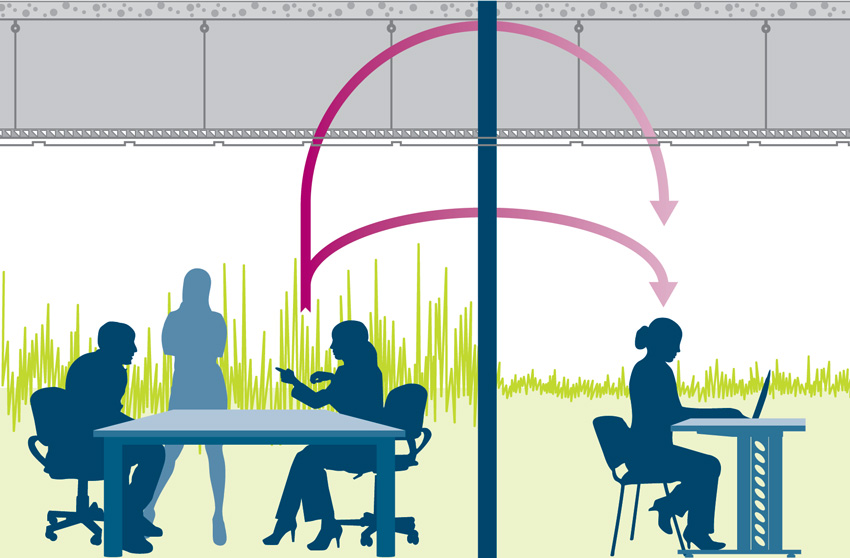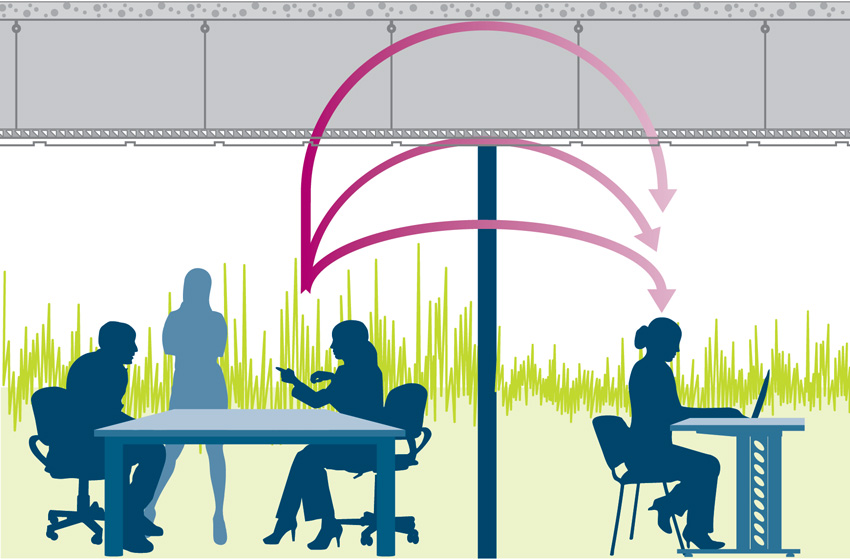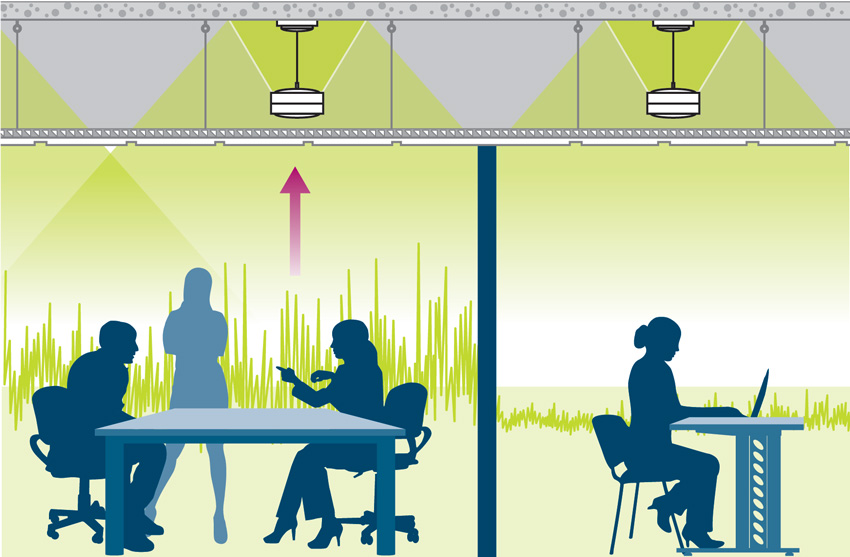Mind the Gap
The Speech Privacy Equation
At the end of the day, whether built from floor to ceiling or deck to deck, walls only address part of the speech privacy equation. A person’s ability to clearly understand a conversation is actually dependent on two variables: the volume of the speaker’s voice and the volume of the background sound level in the space. The relationship between the two is called the signal-to-noise ratio.
Traditional closed-room construction attempts to provide privacy by simply reducing the signal. Even if a deck-to-deck wall is well-designed and constructed (i.e., all penetrations are addressed), it still may not provide the sought-after level of speech privacy. If the background sound level in the adjoining space is lower than the sound passing through the wall, noises and conversations will still be heard and potentially intelligible. With today’s building standards, this is often the case.

© Screen Solutions UK
Option 1: Deck-to-deck construction improves confidentiality but reduces flexibility and increases costs.

© Screen Solutions UK
Option 2: Floor-to-ceiling partitions provide good flexibility but poor confidentiality.

© Screen Solutions UK
Option 3: Installation of sound masking manages the ambient noise level in a partitioned office, increasing speech privacy, while maintaining the flexibility of floor-to-ceiling partitions.
Calculating the Benefits
Sound-masking technology can be used in combination with walls built to the suspended ceiling or demountable partitions in order to provide a cost-effective and more flexible alternative to deck-to-deck construction.
Budget wise, sound masking may represent $1 to $2 of cost per square foot of space, but it offsets much more than that in terms of construction above the ceiling. The ability to provide private rooms with walls to the ceiling also increases the ease and cost effectiveness of relocating them to suit future needs.
But is an equal or greater level of privacy achievable using this alternative?
The most objective method to resolve the speech privacy question is to quantify the effects of increased attenuation and increased sound masking on intelligibility. This exercise can be done using the ASTM standard method (ASTM E1130-08: Standard Test Method for Objective Measurement of Speech Privacy in Open Plan Spaces Using Articulation Index) for calculating articulation index (AI), which is a metric of speech intelligibility and takes both factors into account. While the ASTM standard references open-plan spaces, it is generally agreed that this method can also be applied to closed spaces, with slight modification to the test equipment used.
Calculation of the AI is based on several measurements taken in the space in question, as well as a standardized normal voice level. On-site testing determines the amount by which voice level reduces between the source room and the listener location. This amount is subtracted from the standardized voice level to give the volume in the listener location. That volume is compared to the background sound level in that location. The difference between the volume of the voice relative to the volume of the background in each of the third-octave frequency bands (200 to 5,000 Hz) provides the signal-to-noise ratio in the listener location. The articulation index method assigns a specific weighting formula to determine an AI contribution within each frequency band. These are summed to arrive at the AI value.
Using this method, one can quantify the impact of increasing the attenuation of the wall and that of increasing the masking level, allowing one to compare the two strategies. Obviously, as wall attenuation increases, for each decibel there is an increase in speech privacy levels. Mathematically, the same can be achieved by raising the background sound level by a decibel. To understand why, one need only look to the step in the above AI calculation that determines the signal-to-noise ratio. If a wall decreases the intrusion of voice into the room by a decibel, then the signal-to-noise ratio drops by a decibel. An identical drop occurs when the masking volume is raised by one decibel.
Depending on a variety of factors—including mechanical system noise—the background sound level in closed rooms without sound masking usually ranges from the low 30s to 40 dBA. Levels for sound masking in closed rooms range from approximately 40 to 45 dBA, depending on the size of the room and other conditions. In other words, sound masking typically adds approximately 5 to 12 dBA of ambient volume, which is why one sometimes hears that sound masking ‘adds 10 STC points’ to walls.
Given that the ceiling tile in closed spaces already attenuates sound transmission to neighboring spaces, in most cases, it is unlikely that extending the wall above the ceiling will produce a greater increase in attenuation. This is particularly true if the space’s design follows the recommendation for tiles with a ceiling attenuation class (CAC) of 35 to 40. Of course, if wall and ceiling specifications are low, then benefits may be found by upgrading those elements, while also controlling the background sound levels.









